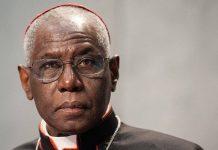Images of Cuba’s patron saint mingled with protesters’ cries of “Freedom!” and “Homeland and Life!”
Image: Archdiocese of Miami.
Newsroom (July 15, 2021 3:28 PM, Gaudium Press) – The whole world remains attentive to the events taking place in Cuba, despite the censorship of information blocking access to what is happening on the island.
The government’s control of the national media and the suspension of internet services has not managed to disguise the widespread demonstrations taking place against the regime. For the past few days, despite the brutal repression by the communist government,
repercussions continue to radiate throughout the world.
However, amidst the confusing bits and pieces of information escaping the prison island, there is a remarkable trace. After decades of veiled (and sometimes open) persecution against religion, Our Lady of Charity of El Cobre continues taking a dominant spot amidst the anti-regime demonstrators. They seem to have chosen her as their patron Saint.
As Images of Our Lady continue to mingle with the echoing cries of “Freedom!” and “Patria o Vida” (Motherland and Life!”), openly challenging the official motto of the socialist regime, “Patria o Muerte” (“Motherland or Death),” similar indicators continue to rise all over the confusing panorama. Among them, Fr. Cástor Álvarez – a priest from the Archdiocese of Camagüey- who was arrested on Sunday and later released after negotiations conducted by his Bishop. He blessed demonstrators with Our Lady of Charity’s image. After decades of communist repression, the Cuban people still have faith in Our Lady, trusting her help.
Critical situation
The message is clear: Cubans are protesting notwithstanding the omnipresent repressive apparatus on the island because the situation is critical. By 2020, Cuba’s already pauperized economy declined a further 11%, while pandemic infections have skyrocketed. Cuba has refused humanitarian aid, including vaccine donations from international organizations. As hopes in human resources seem to collapse, Cubans turn to Our Lady.
However, hopes do not only aim at better sanitary or economic standards: the Cuban people are demanding a political regime change that includes freedom of religion. Ramón Dominguez, president of the Cuban municipalities in exile, expressed in a recent interview: “[in Cuba], there is no freedom of speech, there is no freedom of religion, there is no freedom at all”. And he warns: “[people] have had enough, and when you had enough, you lose your fear.”
Meanwhile, unofficial reports register 171 people arrested during demonstrations. Furthermore, the detention of Camila Acosta, a Spanish newspaper correspondent and leading influencer, is not helping matters. She was arrested while reporting to a Spanish outlet. The incident continues sending shockwaves across international Media.
And notwithstanding the overwhelming force used by Police, rumours register some cracks on the seemingly impenetrable regime’s wall: rumours about the resignation of the deputy prime minister and members of the Castro family having left the country continue to circulate.
Communiqué from the Bishops
Last July 12, the bishops of Cuba issued a communiqué, stating that they could not “close their eyes or turn their faces away, as if nothing were happening in the face of the events that our people have been experiencing.” They understand “that the government has responsibilities and has tried to take measures to alleviate the aforementioned difficulties” afflicting Cuba, but they also understand “that the people have the right to express their needs, desires and hopes, and in turn to publicly express how some measures that have been taken are seriously affecting the people.”
The communiqué received all kinds of observations. Some are in favour, as the document is issued in a repressive and tense environment. Some are against, among them Cuban dissident Carlos Payá, who notes that it is not enough to condemn the government’s calls and measures regarding violence, as the document did not sufficiently emphasize the protesters’ calls for freedom and political change, projecting a false sense of equality between the two sides.
“The Church has to be a beacon that people can look to,” Payá declared, stressing the role played by the Catholic Church in ending Polish communism in the 1980s. He concedes that similar mass demonstrations in Venezuela in 2019 have not brought about lasting change and fears that something similar could happen in Cuba if the Church is unwilling to “step forward.”
As per now, the crushing wave of repression on the one hand and the relatively small international pressure on the Communist regime to allow freedoms, on the other, seem to predict that Cubans will fail in their attempt to break free from a yoke of more than six decades. Yet, the demonstrations and protests may prove successful in one aspect: they have weakened the Castro-sympathizing Left worldwide, exposing the gruesome Cuban reality to the eyes of the international community.
Furthermore: if Cubans truly commit their future to the Queen of Heaven and Earth, She will not fail to answer their cry, one way or another.
With information from National Catholic Register
Compiled by Gustavo Kralj





































